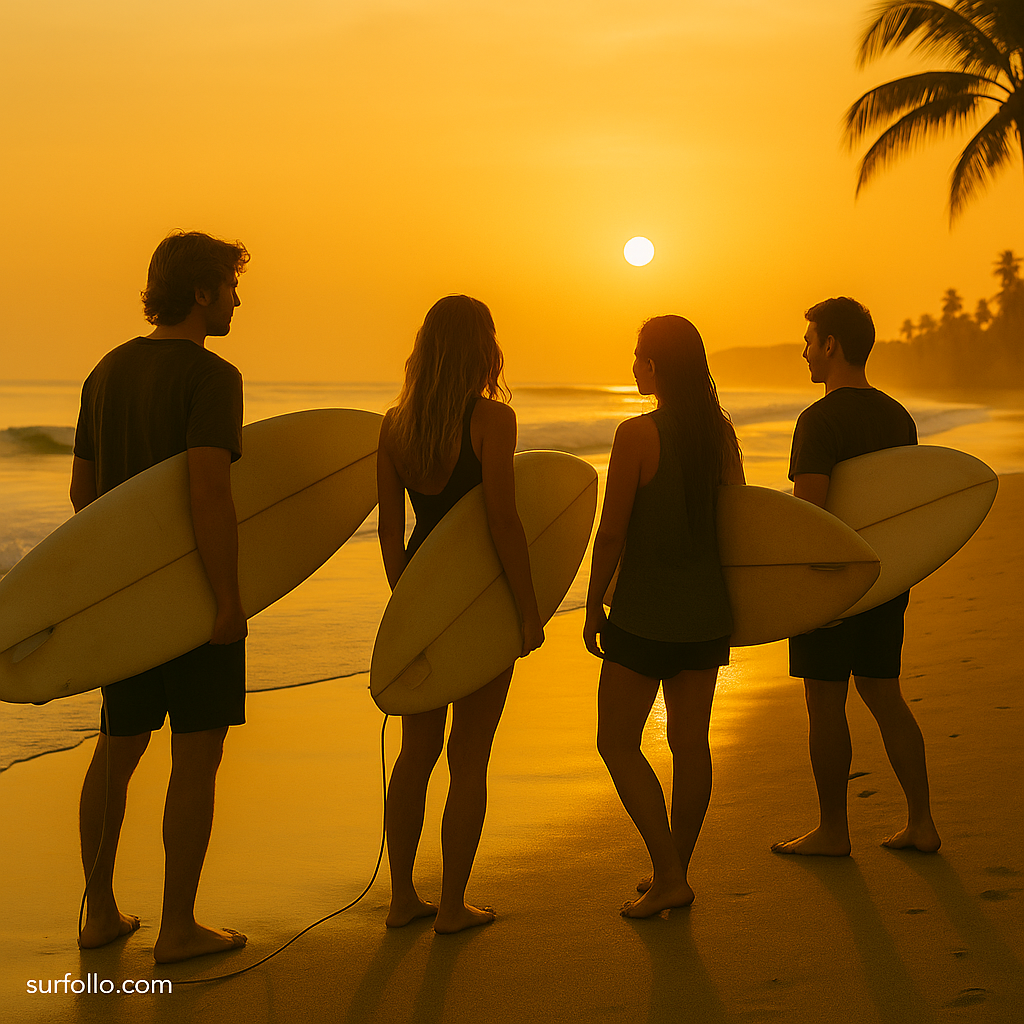
Surfing is often portrayed as a solitary act — one person, one wave, and the vast open ocean. Yet, beneath the surface of that independence lies one of the most tightly knit communities in the world. From sunrise surf checks to beach cleanups and local competitions, surfing connects people through shared passion, respect for nature, and collective stoke.
Surfing doesn’t just build better surfers — it builds better communities. Here’s how.
Shared Passion, Shared Purpose
At its heart, surfing creates instant common ground. Whether you’re in California, Portugal, or Indonesia, surfers speak the same universal language: swell, tides, and wind.
This shared passion breaks barriers of culture, language, and background. Strangers quickly become friends as they trade tips, wait for sets, or celebrate good rides together.
In many ways, the lineup becomes a microcosm of community — a place where patience, respect, and cooperation are constantly practiced.
The Lineup: A Floating Neighborhood
Every surf break has its own social rhythm. You’ll find familiar faces, local legends, beginners, and visiting travelers all sharing the same space. Over time, these small, consistent interactions form trust and friendship.
A friendly nod during paddle-out, a “nice wave!” shout, or even helping someone retrieve a lost board — these moments of connection build camaraderie.
For many, the lineup is more than a training ground — it’s a floating neighborhood, where relationships are built one set at a time.
Mentorship and Passing Down Knowledge
Surfing thrives on mentorship. Experienced surfers often take new riders under their wing, teaching everything from paddling techniques to lineup etiquette.
This tradition mirrors old Hawaiian customs, where surfing (or he’e nalu) was more than sport — it was a spiritual and cultural practice passed through generations.
Today, that spirit continues as seasoned surfers guide newcomers, fostering a sense of belonging and stewardship.
When older surfers share their wisdom, it strengthens community ties and ensures that surfing’s values — respect, humility, and connection — endure.
Surf Clubs and Grassroots Organizations
Across the world, surf clubs and grassroots organizations bring people together through shared purpose.
- Boardriders clubs host local contests and gatherings that unite all levels of surfers.
- Environmental groups like Surfrider Foundation and Save the Waves Coalition connect surfers through ocean conservation.
- Adaptive surf programs make the ocean accessible to people with disabilities, proving surfing’s power to include rather than exclude.
These groups don’t just celebrate surfing — they strengthen local communities by turning individual passion into collective action.
Beach Cleanups and Environmental Unity
Surfers are often the first to notice pollution, erosion, and coastal damage — because they live in direct relationship with the sea. This awareness naturally transforms into environmental activism.
Community-led beach cleanups, plastic-free surf events, and ocean awareness campaigns are now part of surf culture worldwide.
Each cleanup isn’t just about trash removal — it’s about connection. Dozens of people, from kids to pros, work side-by-side with a shared goal: to give back to the ocean that gives so much.
In this way, surfing doesn’t just build community — it creates stewardship.
Surf Travel and Cultural Exchange
Surfing has a unique ability to bridge global cultures. Travelers who chase waves often find themselves immersed in new languages, cuisines, and customs — guided by local surfers who open their homes and breaks.
Whether you’re sharing a meal in a small Indonesian surf town or learning local etiquette in Hawaii, surfing becomes a bridge between worlds.
It teaches humility, adaptability, and appreciation for local communities — and helps the surf world grow more inclusive and globally aware.
Surf Camps and Retreats: Modern Gatherings
Surf camps and retreats have become a modern evolution of the surf tribe — spaces where beginners and pros alike come together to learn, grow, and bond.
From yoga-infused surf retreats in Costa Rica to competitive training camps in Australia, these experiences combine surfing, mindfulness, and connection.
The friendships built in these camps often last long after the waves fade — because they’re rooted in shared adventure and self-discovery.
The Digital Surf Community
Today, the surfing community extends far beyond the beach. Online surf forums, YouTube channels, and social media platforms connect surfers across continents.
While nothing replaces face-to-face connection in the lineup, digital spaces allow surfers to share tips, stories, and environmental news instantly.
Apps like Surfline, Magicseaweed, and Instagram surf pages have created a global surf village — where swells, gear, and inspiration are shared with just a click.
Surfing as Collective Healing
Surfing communities also play a vital role in mental health and healing. Programs like Waves for Change and The Wave Project use surfing therapy to help individuals manage stress, trauma, and anxiety through the ocean’s rhythm.
In group sessions, participants learn to trust, communicate, and celebrate small victories together — turning the surf zone into a sanctuary of growth and unity.
Final Thoughts
Surfing builds community because it connects us to something greater — not just the ocean, but each other.
Every paddle-out, every lineup chat, every beach cleanup is a thread in a larger tapestry of shared purpose. In the water, social status fades, and what remains is pure — a collective love for nature, freedom, and flow.
Surfing reminds us that while the wave may be fleeting, the bonds it builds can last a lifetime.
